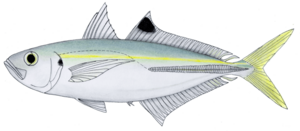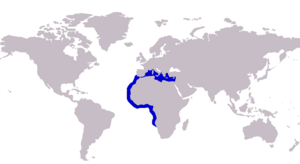False scad facts for kids
Quick facts for kids False scad |
|
|---|---|
 |
|
| Conservation status | |
| Scientific classification | |
 |
|
| Approximate range of the false scad | |
| Synonyms | |
|
The false scad (Caranx rhonchus) is a medium-sized ocean fish. It is also known by other names like the spotfin scad or yellow horse mackerel. This fish belongs to the jack family called Carangidae.
You can find the false scad in the warm and mild waters of the eastern Atlantic Ocean. Its range stretches from Namibia in the south all the way to Spain in the north. It also lives throughout most of the Mediterranean Sea. The false scad looks a bit different from other fish in its family. It has a long, slender body, which helps tell it apart. This fish can grow up to 60 cm long and weigh about 1 kg.
False scads live both near the surface (pelagic) and close to the bottom (demersal) of the continental shelf. They prefer depths from 15 to 200 meters. These fish are predators. They eat small fish, crustaceans (like shrimps), and cephalopods (like squid). As they get older, their diet changes. False scads become ready to have babies at about 2 years old. They usually lay their eggs between April and July in shallow waters near the coast. Young false scads stay in these shallow areas. This fish is very important for fisheries in its range, especially from Morocco to Senegal. People catch them using trawls, seine nets, and gill nets. They are sold fresh, frozen, or salted.
Contents
Understanding the False Scad
The false scad is part of a group of fish called jacks or trevallies. These fish are all in the Caranx genus. The Caranx genus is part of the larger jack and horse mackerel family, Carangidae. This family is then part of an even bigger group called the order Carangiformes.
A French naturalist named Étienne Geoffroy Saint-Hilaire first described this fish in 1817. He found a specimen in Alexandria, Egypt. He named it Caranx rhonchus. The name rhonchus comes from a Latin word meaning 'snorting' or 'croaking'. This is because the fish often makes a sound like that when it's caught. For a while, scientists debated if it should be in the Decapterus genus instead. But now, most agree it belongs in Caranx because of its body features. The name 'false scad' comes from the fact that it looks like a scad, even though it's not in the main scad groups (Decapterus or Trachurus).
What Does a False Scad Look Like?
The false scad is a medium-sized fish. It can grow up to 60 cm long and weigh 1 kg. However, they are more commonly found around 35 cm long. Unlike many other Caranx species, which are deep-bodied, the false scad has a long, slightly flattened body.
Its back and belly curves are about the same. The dorsal fin on its back has two parts. The first part has 8 stiff spines. The second part has 1 spine and 28 to 32 soft rays. The anal fin on its belly has 2 separate spines at the front, followed by 1 spine and 25 to 28 soft rays. The last soft rays of both the dorsal and anal fins are slightly separate, forming a small finlet. Its pectoral and pelvic fins are short.
The lateral line (a sensory line along its side) is slightly curved at the front. It then becomes straight after the end of the dorsal fin. This line has 45 to 55 scales in the curved part. The straight part has 24 to 32 tough plates called scutes. The false scad has well-developed fatty eyelids, especially at the back of its eyes. Both its upper and lower jaws have narrow bands of fine teeth. It also has 50 to 58 gill rakers and 24 vertebrae (backbones).
The false scad is blue-green to olive-brown on its back. Its belly is silvery white. It often has a thin yellow stripe running from its head to its tail. Its fins are clear to dark, but its tail fin is yellow. The tip of the second dorsal fin has a black spot and a thin pale edge. There is also a black spot on its gill cover.
Where Do False Scads Live?
False scads live in the tropical and temperate waters of the eastern Atlantic Ocean. They are more common in some areas than others. You can find them as far south as Namibia, but they usually don't go much further south than Angola. They swim north along the west African coast, reaching Spain in Europe. Their range also extends deep into the Mediterranean Sea. In the Mediterranean, they are found as far east as Turkey, Egypt, and Israel. They also go north to Italy, Greece, and Albania.
False scads live both freely swimming in the water column (pelagically) and close to the seabed (demersally). They prefer sandy or muddy bottoms on the continental shelf. They live at depths from 15 to 200 meters. Young false scads, called juveniles, tend to stay in shallower waters closer to shore. This includes places like estuaries, lagoons, beaches, and marshes.
False Scad Life and Habits
False scads are schooling fish. They form large groups for protection. They often mix with other fish that live in the middle of the water. Like other fish in their family, they are often drawn to human-made devices that attract fish. These are floating buoys used to study fish or for angling. Many studies have been done on false scads because they are so important to fishing in the Atlantic and Mediterranean.
What Do False Scads Eat?
The false scad is a predatory fish. Scientists have studied what they eat. In one area, they found that false scads mainly ate small fish, euphausiids, and other small crustaceans. Interestingly, they didn't eat many copepods, which other small fish often do. As false scads grow, their diet changes. Smaller fish (23-30 cm) mostly eat tiny worm-like creatures. Medium fish (30-35 cm) eat euphausiids and mysids. Larger fish (35-55 cm) mostly eat small fish.
What they eat also changes with the season. During autumn and winter, they eat more crustaceans. In summer, they eat more small fish. False scads eat less during the winter months. They mostly feed around midday and do not eat at night.
Reproduction and Life Cycle
False scads become ready to reproduce when they are about 2 years old. At this age, they are usually around 20 cm long. The time when they lay their eggs (spawn) can be a bit different depending on the location. In the Mediterranean, they spawn from June to August. Off Senegal, it's a longer period, from April to November.
Spawning happens in shallow waters near the coast. The best water temperature for this is about 18.7 degrees Celsius. Female false scads between 29 and 35 cm long can release between 480,000 and 990,000 eggs. They are "partial spawners," meaning they don't release all their mature eggs at once. Some eggs are reabsorbed by the female. The newly hatched fish, called larvae, and young fish, called juveniles, stay in these shallow coastal waters. They grow quite quickly. A one-year-old fish will be about 12.2 cm long. At two years, it will be 17.9 cm. By five years old, it can reach 29.7 cm.
False Scads and People
The false scad is very important for commercial fisheries in its range. The highest numbers of fish are caught off Morocco, Senegal, and in the Mediterranean Sea. Fishermen mainly catch them using large trawl nets, purse seine nets, and gill nets. Sometimes, young false scads are caught in nets closer to shore, like beach seines.
The false scad is part of what is called a 'small pelagics fishery'. This includes several types of fish that live in similar ways. Because other similar fish, like Trachurus species (true horse mackerel), are often caught at the same time, the false scad catch numbers might not always be accurate. Also, sometimes sellers might incorrectly label false scads as 'horse mackerel'.
According to the FAO (Food and Agriculture Organization), between 2002 and 2007, about 1500 to 3700 tonnes of false scad were caught each year from Africa and Europe. Older data shows that much more was caught between 1979 and 1992, with catches ranging from 4000 to 19000 tonnes. The false scad is sold fresh, frozen, smoked, salted, or dried. It is also used to make fish meal and oil. The world record for catching a false scad with a fishing rod is 0.56 kg (1 lb 3oz). This fish was caught off Portugal in 2007.


